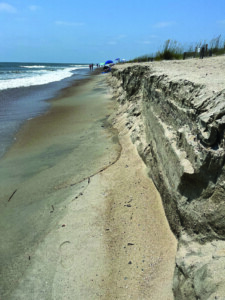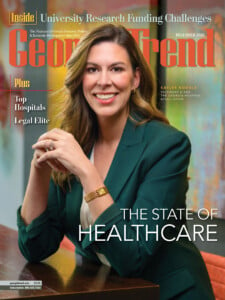Economic Growth Along the Shore: Coastal Georgia
With its rugged beauty and storied history, the coast of Georgia is a huge tourist draw.
Tourism is booming in Georgia, with a record-setting 171 million visitors spending $43.6 billion in 2023. And the coast of Georgia is reaping the benefits. In the past five years, St. Marys, the Golden Isles, Tybee Island and nearby Savannah have experienced a significant increase in tourism, and have avoided major damage from hurricanes and flooding, thanks in part to careful planning.

Nature and History: Scott McQuade, president and CEO of the Golden Isles Convention and Visitors Bureau. Photo credit: contributed
The four barrier islands which comprise the Golden Isles – St. Simons Island, Sea Island, Jekyll Island and Little St. Simons Island – offer visitors a beautiful, natural and unique environment.
“There are very few places left in the country where you can see century-old oak trees and historic landmarks around every bend,” says Scott McQuade, president and CEO of the Golden Isles Convention and Visitors Bureau. The region has preserved a vast amount of its nature and history while at the same time developing quaint island beach communities. Additionally, the nearby port city of Brunswick has its own rich history and downtown area. “Visiting the Golden Isles is almost like going back in time,” he says.
Time-honored traditions are also important to the port city of Darien, where this year from April 11 to 13 visitors can enjoy the three-day 57th Annual Blessing of the Fleet festival, which honors the shrimping community and typically attracts over 12,000 attendees. It will feature nightly live music performances, a 5K run, a classic car show and more.
During the pandemic years, the Georgia coast grew tremendously in popularity. McQuade attributes much of this increase to Gov. Brian Kemp’s decision to leave area beaches open to the public. As a result, there was an influx of tourists from all over the country who had never before been to the Golden Isles.
“Over the last three-and-a-half years we’ve grown over 110%, and our goal is to hold onto those gains,” says McQuade. “We are optimistic that we will continue at this new all-time record pace. Tourism on the coast has never been better. Certainly, it has never been better for all the Golden Isles as a whole.”
Coupled with the increase in tourism over the past several years, McQuade notes the Golden Isles have seen an increase in short-term rental availability and inventory. This means that the region’s overall capacity hasn’t actually changed. “During the pandemic, many people decided to use their housing stock, particularly on St. Simons, as vacation rentals. So the real major impact that we see from the increase in tourism is an increased demand for real estate,” he says.
The Golden Isles are surrounded by marshlands, offering some organic protection from hurricanes. “Our sands are in good shape. The marshes act as a buffer as the storms go into them first and the land second,” says McQuade.
Approximately an hour west of the Golden Isles is the Okefenokee National Wildlife Refuge, which in December 2024 was nominated to join the UNESCO (United Nations Educational, Scientific and Cultural Organization) World Heritage List. This prestigious recognition represents the Okefenokee refuge – and coastal area’s – ecological and critical significance.
Tybee Island

Vital Asset: Alan Robertson, principal of AWR Strategic Consulting, was hired by the city of Tybee Island to oversee its resilience efforts. Photo credit: Frank Fortune
Although Georgia has 368,000 acres of salt marsh, which helps reduce flooding from severe storms, the frequency and intensity of extreme weather is causing problems, particularly on Tybee Island. Known for its wildlife and sea habitat, including sea turtles, in recent years Tybee Island has had to tackle erosion and flooding in its marsh areas.
Working with the U.S Army Corps of Engineers, the island gets periodic beach nourishments (adding large quantities of sand or sediment to beaches) to help build and maintain its coastal resilience. Additionally, Sen. Jon Ossoff and U.S. Rep. Earl “Buddy” Carter are huge champions of Tybee, says Alan Robertson, principal of AWR Strategic Consulting, who was hired by the city of Tybee Island to oversee its resilience efforts. In fact, in 2022 Carter secured $2.6 million dollars in congressional earmarks to help reduce severe flooding on Tybee, and Ossoff’s Tybee Island Storm Risk Management Act became law, ensuring the island has enough resources to protect from sea level rise, storm surge, coastal flooding and beach erosion. That law passed as part of the Water Resources Development Act reauthorization, which extends the Corps of Engineers’ efforts to partner with Tybee over the next decade. Both Ossoff and Carter are “stalwart supporters who work on behalf of the island … to continue our stormwater improvements,” Robertson says.

Tackling a Problem: The Tybee Island Storm Risk Management law ensures the island has resources to protect from beach erosion. Photo credit: Contributed
Robertson says increased tourism – which necessitates development and new construction – coupled with the frequency of extreme weather will have an impact on Tybee Island in the coming years. Tybee is at the “forefront of considering the future demands and future storm activity,” he says.
During the peak of the pandemic, people were flocking to Tybee Island, and tourism was at an all-time high. Cassidi Kendrick, Tybee’s communication and outreach director, says that while visitation for 2024 was down around 20% from those record levels, the city has several initiatives to boost tourism and support local businesses, especially during the winter months when there are fewer visitors. For example, from Thanksgiving 2024 through New Year’s Day 2025, visitors could enjoy free parking on Tybee. Additionally, this past holiday season business employees were offered a 50% discount on their annual parking decals, according to Kendrick, who says over 1,000 employees have already taken advantage of the discount.
St. Marys
While the Golden Isles and Tybee Island are all beach destinations, St. Marys offers visitors a different experience since it’s on the St. Marys River rather than the ocean. As a ferry departure point for Cumberland Island, the city also boasts a walkable downtown and riverfront with shops and restaurants. Cumberland Island National Seashore and Crooked River State Park are main attractions for tourists, says St. Marys Convention and Visitors Bureau Executive Director Angela Wigger, who adds the 2023 opening of the city-owned St. Marys Intracoastal Gateway Marina has brought transient boaters to the area. These visitors typically enjoy docking and then biking or walking around town.
Wigger says overcrowding “has just not been a problem for St. Marys like it has [for] some of the other bigger coastal towns.” And she says St. Marys has plenty to offer. “History enthusiasts, outdoors enthusiasts, this is a great place for them to visit. And we have the additional benefit of being a small town where everything is walkable and then we also have our unique history.”
That unique history includes a visit from Vice President Aaron Burr, who in 1804 fled to the home of a friend in St. Marys after his duel with Alexander Hamilton. Visitors can see the residence, now called The Federal Quarters, which is the oldest home still standing in the town. There are also historic places to stay, including The Riverview Hotel, built in 1916. Its rooms are named after famous guests like steel magnate Andrew Carnegie, oil tycoon John D. Rockefeller and weatherman Willard Scott. For the most part, St. Marys does not have expansive resort hotels, instead offering lodging options on a smaller scale.
Cumberland Island has a 300-person capacity per day that is enforced to preserve the ecology and historic resources of the island. The limited capacity is part of the park’s legislative mandate, according to Wigger. Peak travel times to St. Marys also differ from its coastal island neighbors. The town has two annual travel peaks, with one at the beginning of the year, in springtime, and one towards the end of the year, in the fall. “We do also stay busy kind of in the middle, thanks to our sister cities on the beaches on the other side of us, but our traffic patterns, as far as travel peak seasons, vary just a little bit as well,” says Wigger.

The Nao Trinidad, a replica of Magellan’s ship, docked at the new marina at St. Marys in 2024. Photo credit: Contributed
Like its island neighbors, St. Marys must also take precautions for extreme weather. A post Hurricane Irma and Hurricane Matthew renovation project in St. Marys included the revitalization of some downtown sidewalks, as well as permeable pavement and parking spaces. Additionally, Wigger says the city has added rain gardens and bioswales with salt-tolerant native plants throughout town to help slow the flow of stormwater and absorb its runoff.
“There are very few places left in the country where you can see century-old oak trees and historic landmarks around every bend. Visiting the Golden Isles is almost like going back in time.” – Scott McQuade, president and CEO, Golden Isles Convention and Visitors Bureau
Savannah
Joseph Marinelli, president and CEO of Visit Savannah, the destination marketing unit of the Savannah Chamber of Commerce, has been very impressed with the collaboration between Savannah and Chatham County with regards to storm preparedness and messaging to locals and visitors. Marinelli has lived in Savannah for 18 years and knows each storm can bring with it a different flooding or destruction challenge.
“Speaking as both a resident as well as a business leader, the collaboration between Savannah and Chatham County’s emergency management group during the four back-to-back storms in 2024 – including Hurricane Helene and Hurricane Milton – was the best that I have seen yet,” Marinelli says.

Impressed with Collaboration: Joseph Marinelli, president and CEO of Visit Savannah, the destination marketing unit of the city’s chamber of commerce. Photo credit: Contributed
Marinelli notes that the increased tourism to Coastal Georgia has offered Savannah the opportunity to attract tourists who will return to the area. “We want a visitor who is going to stay longer, spend more, come back again in the future – and tell their friends and family,” Marinelli says.
The Savannah Convention Center’s $276 million recent expansion, which adds another ballroom and doubles the existing SCC’s space, is going to greatly aid in attracting conventions of all sizes. Marinelli says that as a visitor destination, Savannah is typically very busy on most Thursday, Friday and Saturday nights. “So we will use this expanded convention center to attract both new conventions and larger conventions during the earlier part of the week,” he says. “On the weekends, we want to target the type of visitor who is going to come back again and spend more while they’re here.”
AWR’s Robertson sums up Coastal Georgia’s significance succinctly, saying: “The coast of Georgia is an economic engine. It is vitally important to Georgia’s economy.” Luckily for current and future visitors and residents, it appears that this sentiment is widely shared.

Grand Entertainment Ship: The Georgia Queen offers riverboat cruises in Savannah and hosts special events like weddings, holiday parties and corporate gatherings. Photo credit: Contributed











